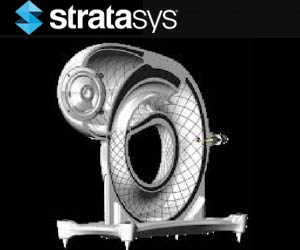You can’t solve an 80-year-old problem with 80-year-old technology. Take stereo speakers, for example. Conventionally designed and manufactured speakers almost universally suffer from some level of “back wave” distortion; this occurs when the audio signals fired to the back of the speaker bounce off the cabinet walls and interfere with the signals sent to the front of the speaker.

In the 3D printed Aleph1 speaker design, sound travels in a perpetual self-feeding loop, preventing it from interfering with the signal outputting to the front, for extraordinary acoustics.
To solve the problem without using acoustic absorption, industrial designer Boaz Dekel, a graduate of the Bezalel Academy of Arts and Design came up with a truly unique solution: Eliminate the speaker’s back wall. Dekel conceived of a circular speaker in which sound travels “in a perpetual self-feeding loop that prevents it from interfering with the signal outputting to the front,” as he explained to the Stratasys Blog.
Sounds like a great idea? Yes. But it also sounds impossible to manufacture using conventional tooling methods. So Dekel turned to Stratasys 3D printing to prototype his design.

The Aleph1 speaker being 3D printed in one piece on the Objet500 Connex3 color, multi-material 3D printer.
Using the Objet500 Connex3 3D Printer employing PolyJet multi-material capabilities, Dekel began turning his vision for the Aleph1 speaker into reality. After testing various Stratasys digital materials, he found the perfect combination of rigid and flexible material properties to achieve the right balance of design, aesthetics and acoustic properties.
“With 3D printing I was able to quickly study the acoustic response of the geometry and different material configurations and determine which was most applicable to speaker cabinets. Other manufacturing or modeling techniques would not allow such freedom, much less in the required time frame,” Dekel said.
The Aleph1’s unique self-feeding geometry preserves the acoustic energy of the back wave and allows this energy to participate in the process of sound reproduction, resulting in a clean, open and natural sound with high detail and great separation.

The functional prototype of the Aleph1 speaker was produced using Stratasys’ PolyJet multi-material 3D printing (no assembly required) and demonstrated at the Stratasys booth at Formnext 2015.
Dekel stated “The model is 3D printed in a single piece to allow complex internal geometries while maintaining structural integrity. Having a physical model was instrumental to studying the theoretic principles behind the product and assessing its feasibility.”
With this never-before-seen (or heard) design, Dekel hopes that this opportunity to combine his passions for audio and design will have commercial possibilities. Stratasys was proud to play a part in smoothing the way for this fresh take on a consumer product. Keep your ears open for more news!
Find out how you can use Stratasys 3D printing to solve design challenges with unique product ideas by clicking on the button below.








Leave A Comment